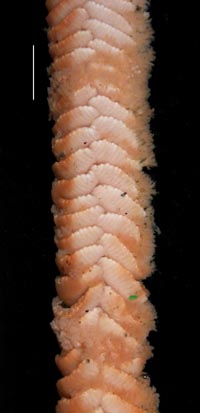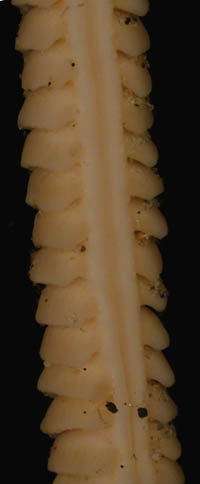CONTENTS
Introduction
The South Atlantic Bight
Methods
Octocoral Morphology
Glossary
Gorgonacean
Bauplan
see this for keys
Notes on the Species
Carijoa
riisei
Scleranthelia
rugosa
Telesto fruticulosa
Telesto nelleae
Telesto sanguinea
Bellonella rubistella
Pseudodrifa nigra
Nidalia occidentalis
Iciligorgia schrammi
Diodogorgia
nodulifera
Titanideum
frauenfeldii
Muricea pendula
Thesea nivea
Bebryce cinerea
Bebryce parastellata
Scleracis guadalupensis
Paramuricea sp.
Leptogorgia hebes
Leptogorgia punicea
Leptogorgia
cardinalis
Leptogorgia virgulata
Leptogorgia setacea
Leptogorgia euryale
Viminella
barbadensis
Renilla reniformis
Sclerobelemnon
theseus
Stylatula elegans
Virgularia presbytes
| Guide
to the Shallow Water (0-200 m) Octocorals of the South Atlantic
Bight.
S. T. DeVictor
& S. L. Morton, 2007
Virgularia presbytes
Bayer, 1955 Remarks. Virgularia presbytes maintains a rigid, pen-like colony shape that has overlapping, fleshy leaves comprised of numerous autozooids, fused at the base in a fan-like manner. On the ventral side, the edges of the leaves are arranged in an imbricating manner, but they do not touch dorsally where they leave a very distinct bare track with a medial groove. The presence of the autozooids causes the leaves to appear heavily ridged. Between the leaves are small siphonozooids in multiple rows, visible only when the larger leaves are lifted to expose the rachis. The axis is white, rigid and becomes flattened towards the base. V. presbytes usually lacks spiculation. Atlantic distribution: North Carolina to Florida, Gulf of Mexico, Trinidad and Tobago, Surinam, and Brazil, 9-91 m (Bayer, 1955; Bayer, 1959b; Bayer, 1961; NMNH collections; SERTC collection).
Virgularia presbytes, preserved specimens (S2125): (top left) polyp leaves with autozooids (scale bar = 5mm); (right) full colony; (bottom left) bare dorsal track.
|
|
 |
 |

